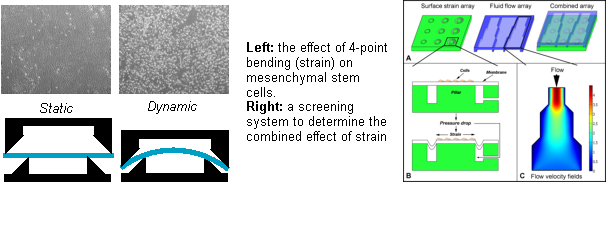Staff members
- Dr. ir. Jeroen Rouwkema (coordinator)
- Prof. dr. ir. H.F.J.M. Koopman
- Prof. dr. ir. N. Verdonschot
Background
Mechanical forces play an important role in tissue development and homeostasis. Our goal is to understand the response of cells to mechanical signals and to use this knowledge to predict tissue behaviour and development.
Mechanobiological modelling
When compressing a tissue or a tissue engineering scaffold (A), the deformation will not be uniform throughout the structure. Using Finite Element Models, the local deformation can be determined (B). This information can then be combined with a mechanobiological algorithm (C) to predict local tissue development (D).

In vitro models
A mathematical model is only as good as the data and assumptions used in it. Therefore, we are actively developing and using in vitro model systems to determine the effect of mechanical signals on cells. These model systems are used both to generate input for the mechanobiological models and to validate the results of the models.

Application areas
The application areas of this research line are diverse, including tissue engineering (A), bone remodelling (B) and orthopaedic implant integration (C).

Collaboration
- The Tissue Regeneration department (Prof. Clemens van Blitterswijk), University of Twente
- BIOS, The lab-on-a-Chip group (Prof. Albert van den Berg), University of Twente
